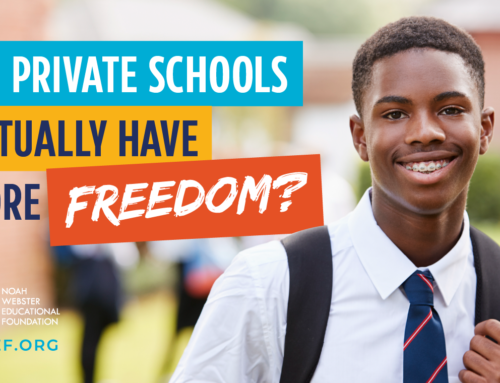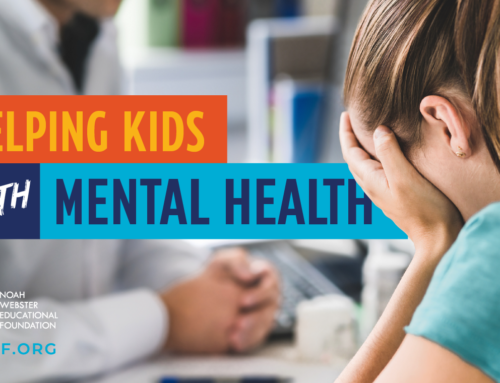
Why do schools fail? A quick answer might be, “Well, they didn’t have enough money.”
That’s true, money is a big issue for many schools. But, it’s not necessarily a lack of money that causes schools to fail. Most of the time, there are other underlying problems that force a school to close down.
So, what can be done to solve the problems that lead to a failing school? To answer that, we talked with Jack Appleby, who’s worked in education for 46 years. Having served as a teacher, administrator, and interim superintendent, Appleby has been on all sides of the school budget. He’s found how to properly manage a school budget and learned the essential components that make up a successful school.
In his interview with the Noah Webster Educational Foundation’s president Melvin Adams, Appleby discusses the problem with school funding. He reveals the real reason why schools fail.
NWEF PRESIDENT MELVIN ADAMS:
“Let’s talk a little bit about failing schools. The solution often sought is to increase funding, but we rarely see an increase of funding fix failing schools. How do we get resources directed for the greatest benefit to the student?”
JACK APPLEBY:
“A failing school has nothing to do with money. A failing school has everything to do with relationships. It has everything to do with leadership. It has everything to do with what happens in the classroom. It has everything to do with what happens between the school and the community.
And so the issue is that there are failing schools. That’s why you can’t compare a rural school to a suburban school or an urban school. An urban environment is completely different, and the kids that you’re getting are completely different. The school I’m currently working with, their graduation rate is 100%, and 100% of the kids go on to four-year institutions. The four-year institutions they go to are in the top 100 universities in the United States.
Well, that’s not a typical group! Not a typical school! So you gotta look at the community, you gotta look at the leadership…I would chalk it up to leadership. Schools fail because people fail. And they fail in how relationships at school should work. A school is to be a community. That’s what it started out as, and we need to maintain that.”
ADAMS:
“So what I’m hearing you say is that failing schools are not failing because of lack of resources, typically. Failing schools are failing because of other issues. Throwing more money in the failing schools is throwing good money after bad.”
APPLEBY:
“Exactly right! If you wanted my idea about how you fund schools, a school that has to struggle a little bit for its money will be more innovative because they have to be. Innovation and funding are connected.
When money is fat—when it was fat at Greencastle, I could blow up some of my accounts and hide money (now I don’t mean that in a real sense), but when money got tight and the closer I had to budget—the more budget transfers I had to do as the year went on—the better the school year was because I was maximizing what I had. I was maximizing my resources.
When you maximize your resources, you get very creative. And you get your teachers to be creative, and you get your department heads to be creative. So, if there isn’t a little pain in the budget, I question it. I think a little pain is good. Just like in the home budget. Some months are a little tighter than others—you have enough, but you really have to be conscientious. And I think that’s where purposefulness and long, strategic planning [come in]…because you’re not going to build a building without planning. You’re not going to do some big project without planning. But if you just divvy out money without thinking about it, it just becomes a bottomless pit.
I’ll give you my pet peeve. Technology can be a black hole. You can invest a lot of money into technology and get little benefit out. Remember, I’m not talking about benefits for the school, but for an individual kid: ‘What am I gaining by this program?’ And we keep losing focus of that student. How is it improving how this student is going to matriculate through the program? Or how is the student going to get a better program by this investment?
We never look at that. If you’re a business, you look at your monetary investment completely different than an educational system. I think the two of them need to come together a little bit better.
That’s one of the dangers though, some people try that, and then that’s where they get these artificial pieces of data, ‘Well, I’m going to look at this scientific test score’ or ‘this, this, this, this,’ but then they forget that teaching also is an art.
So, you have to find a way, as a leadership person like yourself, how do you give room for that to occur, and yet understand that you’re not making widgets here. Human beings are the most unpredictable resource that you have.”
ADAMS:
“Let’s switch a little towards facilities and budgets. Facilities are a significant factor in many educational models. Perhaps least so in homeschools, but many school districts are under pressure to build new campuses—passing on significant costs to local citizens through raised taxes.
Facilities account for a significant portion of most school budgets. While facilities are important, they don’t really educate. Would you care to speak on what you consider essential facilities and what reasonable portion of a budget they should receive?”
APPLEBY:
“Right. Facilities you must have. You must have good facilities. It’s sort of like being in a neighborhood. You have to keep your house up with everybody else’s. But facilities are an investment, and in Pennsylvania—I think it’s every 20 years— you get help from the state to help update your facilities.
But with the recent pandemic, and with what we have faced, we have found that bricks and mortar—really—we can look at a little bit differently than what we looked at in the past. You can capitalize on scheduling—and do you realize time is still an issue for us in education? How we package time. If we looked at packaging time differently, we could maybe do more with what we have and not have to build more.
For instance, you can have models of school that are more of a college model—every other day, whatever—and that, particularly, is helpful for the secondary level because they’re not as dependent as elementary, with parents working and stuff. You know, they can go home; it can be done. So you need to look at the schedule. How can you package time differently? How can you package the school year differently? That could be an issue.
The only facility that you really do need would be an advanced laboratory—science rooms are always expensive, band rooms. But really, you could also do a lot of co-oping with other agencies. For instance, you could co-op with some businesses that are tied in the community and do what we used to call shop classes. They would love to be involved.
So you can look at alleviating that expense. But if you do have facilities, the one thing you must spend money on—which most districts cheat—is maintenance and custodial. Because the first thing, when a parent comes in, if those walls and floors aren’t shining, you’ve already created a negative expectation.
Custodial was number one priority—I supported my custodians 100% to keep the rooms clean, sweep every day, pick up paper in the hallway… That’s crucial! Take care of your building. Like I told you earlier: school buildings don’t wear out, we just lose the energy that’s needed to use them creatively—now I’m not talking about asbestos and that kinda stuff that’s historical—but school buildings don’t wear out, so we need to think about how to use them better.
So in your budget, really—other than building a new school building—a building doesn’t cost you near as much as what it costs you to put people into that building. The salaries of your personnel, your secretaries and everybody, amounts to about 70% of your budget. So it’s not the building. The issue is, do you have enough forethought when you are building that you’re not building a Taj Mahal, but you’re building something that will have longevity? And are there other ways you can use it? Can the community benefit from it?
We make schools almost like an oasis, and no one dare touch it in those off months. Well, heavens, we need to change our mentality about what that looks like. Remember we talked about career planning? So I might find a group of kids that would love having a unique schedule where they work synchronously with a teacher online at a certain time so they’re not actually in my school building.
Or I might develop co-op programs—and I did that. My superintendent said, ‘Can you have 100 less seniors in the building? Can you develop a program?’ I said, ‘Well yeah, I can do that.’ So I developed a co-op program. I took juniors and seniors, and they could go out and connect with a business (and I had a co-op advisor), and they could find out if they wanted to move in that area as part of their career path.
So I had kids going out with surgeons in the local hospital in Chambersburg, and they found out after spending a day with an orthopedic surgeon, that being a surgeon is sort of like being a mechanic. That all you did was cut out joints and put new ones in!
There’s all kinds of ways you can get creative. That’s my job—to be creative. I don’t think there’s much creativity in that side, but if you have it, take care of it, ‘cause it’ll last. But most people when they want a balanced budget will cut custodial maintenance services. And that’s the last thing you need to cut.”
ADAMS:
“Well that runs right into my next question. Services also account for a significant portion of many schools’ budgets—especially in government schools—so you’ve got things like transportation, meals, etc… we’ve already talked a little bit about that, but if you could summarize, what insight and solutions would you give for those essential services and the budget side of that?”
APPLEBY:
“Well, transportation is always a big one if you have a large school district. We were lucky and had a bus buy-back program. So we had a program where buses were only with us [for a time], then they’d end up selling those buses and always be rotating inventory for us. We broke them in, and they sold them later. So we didn’t own the buses—that’s an important piece.
But [if] you have to provide transportation, then there’s a limit that you can provide—and that’s mostly dictated by law. And most of our kids that—by law—could walk, didn’t walk because we provided transportation. So transportation is a big thing.
Foodservice is also a tough one. In the olden days, you got a lot of federal surplus, and they don’t give that away anymore. That would be one of the ways that the government would have food service, and you could give… because cafeterias really find it difficult to run in the black. Cafeterias typically run in the red. It’s labor-intensive, and the kids are a tad snoopy, and the menus are a problem. So a lot of bigger schools have gone to contract services—so they’ll contract with Burger King or McDonald’s—and they come in and subsidize. That’s another way you can save.
But yeah, those things you just have to figure out the best way of doing it, and it’s unique to your environment. In the olden days, they used to have lunchtime, and the kids could go downtown. But that was eliminated for a variety of reasons before my time. But your cost, Melvin, always comes down to people. If you gotta balance your budget, you gotta cut programs—which means you cut people.
And that’s why, when budgets get out of whack, that is where you have to go. You have to go to people. If the enrollment drops, you gotta eliminate people. Eliminating people is tough.
The other thing is, people are going to cost you more money every year—more money in their salary, money in benefits. And of course now, contracts are being set that you do a lot of cost-sharing, like with insurance and so forth.
But really, the important part of building—going back to that one—is the planning upfront. And are you planning long term, or are you just building something that looks nice? And again, I don’t see enough planning, I don’t see leaders thinking out. It’s more like wanting to show off—I hate to say it. It’s like having the newest car, or the newest this, or the newest that. I don’t think it is the newest that is important.
I think that education can take place in a barn if you have the right people. So if I had to invest money in building, I would invest money in people instead, and not building. And I would invest money in thinking about other ways of delivering the service and looking at how we package time.”
How can you influence your local school’s budget and facilities choices? You can start by getting involved so you know what’s going on in your school. Attending school board meetings is a great place to begin.
Here at NWEF, we provide articles and actionable resources so you can start making changes in your district, vote for more school choice, and encourage your child’s teachers.
Sign up for updates to stay informed about ways you can make a difference.





[…] (Does adding more money solve school problems? Here’s why more funding isn’t always the answer.) […]